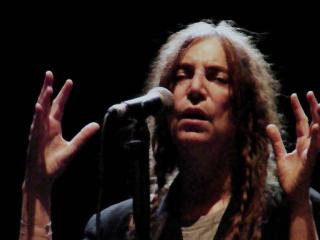Storytelling is all the rage these days — and everyone seems to have a life narrative. But not philosopher Galen Strawson. He says life stories often create an inauthentic version of ourselves.More
Interviews By Topic
Legendary poet and singer Patti Smith has two selves. On stage, she revels in collaborating with the people around her and creating a memorable performance. But she reveals a very different self in her memoir "M Train." More
Prince Marfo is the Suyani Cultural Director of Ghana. He says his government needs to do a better job of welcoming African Americans — he wants to see them welcomed as sisters and brothers not just as Americans with resources.More
It's one thing to imagine the intelligence of a forest, but could you experience it? The Japanese concept of "forest bathing" might help. Forest guide Amos Clifford is a former Zen teacher who's one of the world's experts on forest bathing.More
Richard Powers’ “The Overstory” has overturned a lot of conventional thinking. Though human characters shape the plot of this 500-page epic, the real heroes are trees.More
Suzanne Simard is a forest ecologist who's revolutionizing our understanding of trees. She has discovered that trees use underground networks to communicate and cooperate with each other. It turns out that whole forests can exist as a superorganism.More
There's a famous sequoia named General Sherman that's the biggest tree on the planet. It has its own distinctive history linked to the Civil War general and a radical anarchist group. Cultural historian Daegan Miller tells this fascinating story.More
Ethnobotanist Gary Paul Nabhan has been called the “father of the local food movement.” Many of his insights come from the farming practices of Indigenous people living near the U.S.-Mexico border, who’ve grown food in arid habitats for centuries.More
Locking eyes with another creature in the wild can be a profound experience. For physicist and writer Alan Lightman, half a second of eye contact with a pair of ospreys felt like an epiphany.More
In Chicago, writer Gavin Van Horn and environmental artist Jenny Kendler visit her new art installation, which confronts viewers with the gaze of 100 giant bird eyes. It's meant to provoke curiosity, wonder, and awareness of how many non-human eyes are always watching us.More
There are two famous moments that helped shape environmental politics. Gavin Van Horn, of the Center for Humans and Nature, tells us what happened when Aldo Leopold met the eyes of a dying timber wolf and when Paul Watson looked into the eye of a dying sperm whale.More
In 1960, a young primatologist stared deeply into the eyes of a wild chimpanzee. She was Jane Goodall. He was David Greybeard. Their mutual gaze changed animal science forever.More
Pardeep Singh Kaleka's father was murdered when a white supremacist attacked the Sikh temple that his father led. Remarkably, he and a former white supremacist met just two months after the massacre. Now, they work together.More
Daniel Ziblatt has watched authoritarian leaders elected in country after country – Putin in Russia, Erdogan in Turkey, Orban in Hungary, Bolsinaro in Brazil. He says there’s a playbook for how demagogues destroy their countries' democracies.More
A psychedelic research center in Wisconsin is gearing up to manufacture enough medical-grade psilocybin to supply the world. Steve Paulson went to Usona Insitute to see where the magic's made, and got a peek inside the lab of chemist Alex Sherwood.More
"White Fang" by Jack London is a classic outdoor adventure story about a wild wolf-dog's struggle to survive in the Yukon Territory during the 1890's Gold Rush. Writer Quan Barry read it for the first time at age 11 and learned just how powerful a book can be. More
“The Adventures of Huckleberry Finn” by Mark Twain is one of the most controversial books in the American literary canon, particularly because of its frequent use of the N word. But for Enrique Salmon, a young Native kid trying to master the English language, “Huckleberry Finn” was the book that launched his lifelong love of reading.More
English author and professor Katherine Rundell thinks all of us – even adults – can benefit by reading books primarily meant for kids. Reading children’s books might inspire us to take chances, learn new things and go — literally and figuratively — to new worlds.More


















